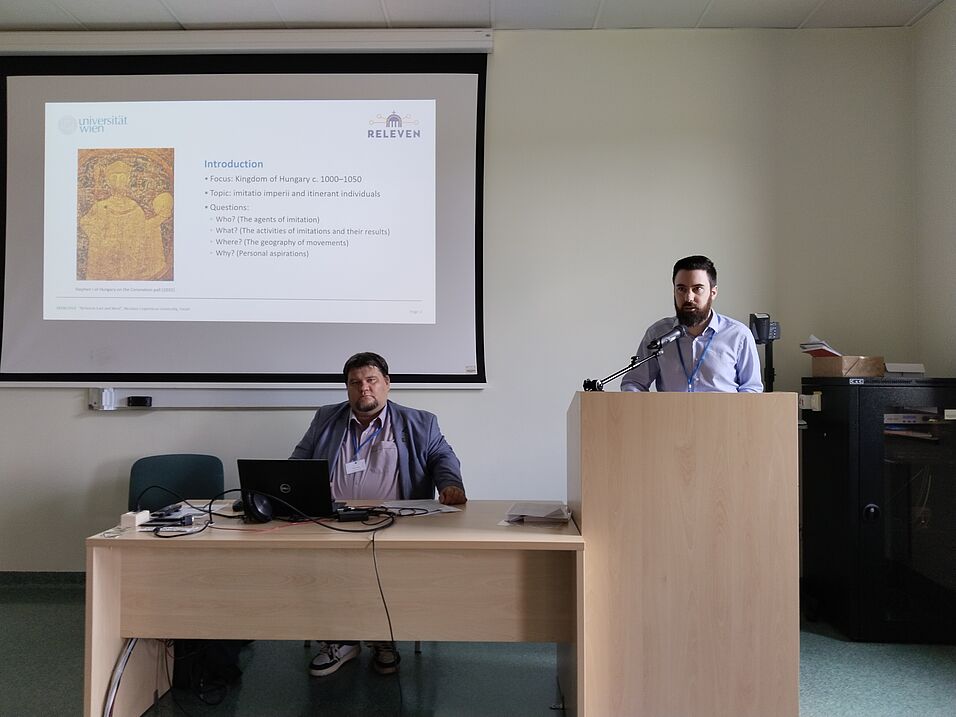Chronicles, seals and imitations
Many tasks have been done since my last post in January 2024. At the beginning of May, I felt I had skipped the second half of April. That period seemed so short due to the simultaneous tasks. As for the whole time since the former blog post, I wrote an article about using historical dates in the RELEVEN database and contributed to a multi-author report on our project with a chapter. I also attended an international conference that revolved around the memory of Rome. In the meantime, I continued my research on the movement of individuals in Central Europe and the collection of prosopographic data in the same region. Furthermore, I reviewed some Byzantine data transferred from the PBW to RELEVEN database and fought with the searching and browsing functions of WissKI during this assignment. In the following parts of this post, I am will treat three of these tasks in more detail.
Central Europeans on themselves
One of my main assignments in the spring was the collection of prosopographic data from Central European sources. As I mentioned in my previous post, I mostly worked on the remarks of Holy Roman historical writings on events and individuals connected to Central Europe. The annals and chronicles written in the eleventh-century Holy Roman Empire are essential sources since they were produced in different periods of the century, providing numerous almost-contemporary narratives about the events of Central Europe. The only major issue is that this material naturally does not focus on the region. Historical works compiled in Central Europe are vital for the history of local polities, but they were written after the eleventh century or are preserved in later versions. Consequently, the evidence for the first half of the eleventh century in this literature is even more scattered and limited. Data collection included the Chronica Bohemorum by Cosmas of Prague, the Gesta principum Polonorum by the so-called Gallus Anonymus, the Gesta Hunnorum et Hungarorum by Simon of Kéza, the Hungarian Chronicle, and different minor sources such as letters, saints’ lives and official documents.
The historical works raised several problems for the prosopographical analysis. Most of the problems derive from the fact that they are not near contemporary to the events. The Chronica Bohemorum and Gesta principum Polonorum were written in the early twelfth century. The Hungarian Chronicle only survived in different versions from the 13th (Gesta Hunnorum et Hungarorum) and 14th centuries (the two manuscript families of Chronicon Budense and Chronicon Pictum respectively). There are only hypotheses about the true beginning of the Hungarian historiography (a date varying from the 1050s to the 1280s by different scholars). One of the problems coming from the late compilations is the lack of details from the first half of the eleventh century. Another issue is that the chronicles shape their narratives to represent ideal rulers. We can see this effort in the cases of Stephen I of Hungary and Bretislav I of Bohemia. Such a tendency questions the validity of data and also leads to long but superficial accounts of events. It is not always easy to decide how I can turn the details into sensible data for a prosopography. Nonetheless, the local chronicles of Central Europe are still invaluable sources of my research.
A conference in Toruń
From 17–19 June, I attended an international conference, “Between East and West. The Power of Memory and Remembering of Rome. Continuity of Past and the Role of Authority in the Middle Ages” at Nicolaus Copernicus University in Toruń, Poland. I presented a paper about the role of moving individuals in the so-called imitatio imperii in Hungary from 1000 to 1050. Imitatio imperii, the imitation of the Roman Empire, either meaning ancient Rome, the Byzantine Empire or the Holy Roman Empire, was (and still is) a regular policy of several states or polities since the Late Antiquity. Evidence shows that the royal court of Hungary also borrowed some imperial ideas for its representation, political ideology and rituals. In truth, most participants in the imitation were likely moving individuals due to the circumstances in the period (for example, the itinerant court). However, evidence shows some definite roles (performing specific skills, transfer of knowledge, interposition, etc.) played by the contributors that are worth our attention. After the presentation, I had a long discussion with Przemysław Wiszewski, a renowned expert on the early medieval history of Poland, about the effect of cultural connections on the politics of Central Europe.
Byzantine lead seals
There is an ongoing assignment I was given recently, and it is related to the sigillography data of the Prosopography of the Byzantine World (PBW). Lead seals are important sources of Byzantine history, and the PBW database greatly relies on this material. RELEVEN also intends to insert this sigillographic data into its own database. Yet, our project leader, Tara, created a specific data model for seals, and transferred the sigillographic data of PBW to the RELEVEN database. The main problem with the dataset of PBW is that the collection of sigillographic information ended in 2009. There has been no attempt for an update in this section since that year. However, a lot of important publications, catalogues and articles, were released in the meantime. The new studies on Byzantine lead seals revealed formerly unpublished pieces or gave essential corrections to previous analyses and descriptions. My task is to find eleventh-century lead seals missing from the PBW dataset and add their relevant data to our database. As of now, I have done some initial steps, especially troubleshooting in our input system, WissKI. Thus, it will be a huge work in the following months.

